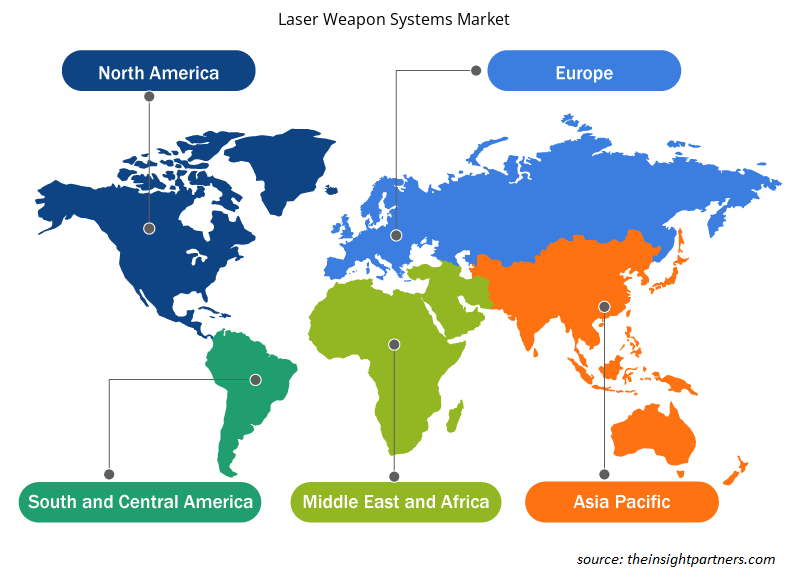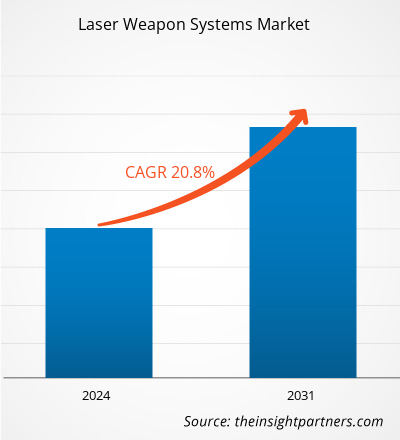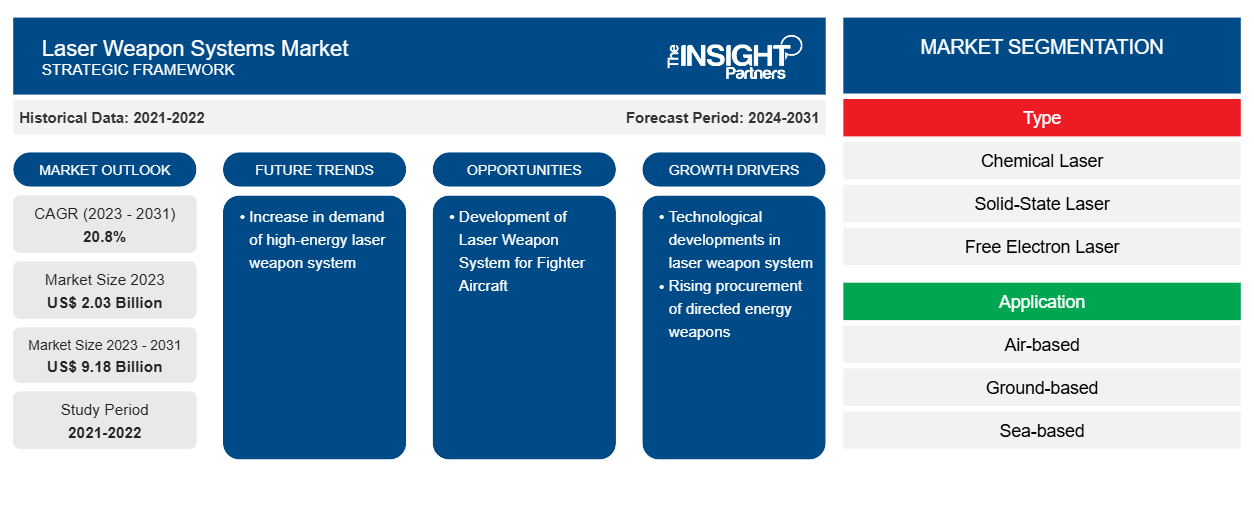Si prevede che la dimensione del mercato dei sistemi di armi laser raggiungerà i 9,18 miliardi di dollari entro il 2031, rispetto ai 2,03 miliardi di dollari del 2023. Si prevede che il mercato registrerà un CAGR del 20,8% nel periodo 2023-2031. È probabile che l'aumento della domanda di sistemi di armi laser ad alta energia rimanga una tendenza chiave nel mercato.
Analisi di mercato dei sistemi di armi laser
Lockheed Martin Corporation, L3Harris Technologies Inc., Leonardo DRS, Northrop Grumman Corporation e Rheinmetall AG sono tra i principali attori del mercato che operano nel mercato globale dei sistemi di armi laser. Gli attori principali sono elencati considerando fattori quali fatturato complessivo, attuale portafoglio di prodotti di sistemi di armi laser, portata geografica, iniziative di mercato, investimenti in aggiornamenti tecnologici, partnership e altre attività correlate al mercato.
Panoramica del mercato dei sistemi di armi laser
L'ecosistema del mercato dei sistemi di armi laser comprende i seguenti stakeholder: produttori di componenti, produttori di sistemi di armi laser e forze di difesa. Gli attori del mercato della produzione di sistemi di armi laser acquistano componenti come sensori, supporti di tracciamento, rilevatori di fascio e altri pezzi di ricambio da vari fornitori in tutto il mondo. Questi fornitori ottimizzano continuamente le loro linee di produzione e i tempi di consegna al fine di migliorare la rispettiva catena di fornitura. I produttori di sistemi di armi laser stanno assistendo a una domanda significativa per i loro prodotti a causa della crescente minaccia degli UAV negli ultimi anni. Il fornitore di sistemi di armi laser lavora in sincronia con l'acquirente del sistema di armi laser al fine di comprendere la domanda dell'acquirente o degli utenti finali. Ciò aiuta i produttori di sistemi di armi laser a soddisfare adeguatamente le esigenze dei rispettivi clienti. Le forze di difesa sono gli utenti finali, che continuano a cercare sistemi di armi laser ad alta energia, alta precisione e a lungo raggio per la loro flotta di difesa. Diverse forze di difesa lavorano a stretto contatto con i produttori di sistemi di armi laser come Raytheon Technologies, Lockheed Martin Corporation e altri al fine di incorporare il miglior sistema possibile nella flotta di difesa. Questo fattore spinge anche il mercato dei sistemi di armi laser militari.
Personalizza questo report in base alle tue esigenze
Riceverai la personalizzazione gratuita di qualsiasi report, comprese parti di questo report, o analisi a livello nazionale, pacchetto dati Excel, oltre a usufruire di grandi offerte e sconti per start-up e università
-
Scopri le principali tendenze di mercato in questo rapporto.Questo campione GRATUITO includerà analisi di dati che spaziano dalle tendenze di mercato alle stime e alle previsioni.
Driver e opportunità del mercato dei sistemi di armi laser
Sviluppi tecnologici nel sistema di armi laser
I miglioramenti nelle tecniche laser hanno portato ad armi laser ad alta energia con una gittata maggiore. Le aziende che sviluppano armi laser come Raytheon Technologies, Lockheed Martin Corporation e Dynetics Inc. stanno introducendo nuovi sviluppi nelle tecnologie laser. Ad esempio, Lockheed Martin sta portando avanti i suoi sforzi per fornire laser ad alta energia e Integrated Optical-Dazzler with Surveillance (HELIOS) per la Marina degli Stati Uniti combinando ISR a lungo raggio, armi laser e capacità anti-UAS per migliorare la consapevolezza della situazione e la difesa a strati. Analogamente, Raytheon Technologies ha assegnato contratti da 15,5 milioni di dollari per sviluppare un sistema di armi laser montato su buggy aggiornato. L'arma può distruggere droni o piccoli sistemi aerei senza pilota entro 3 km con un controller in stile gioco e un laptop.
Sviluppo del sistema di arma laser per aerei da caccia
I sistemi di armi laser stanno riscuotendo una forte domanda da parte di paesi con un elevato potere militare a livello globale, come Stati Uniti, Russia, Cina e India. Il crescente sviluppo delle armi e il crescente numero di droni nelle operazioni militari stanno creando una domanda di armi difensive avanzate . Un gran numero di droni e armi avanzate può creare gravi danni a causa dei quali la domanda di sistemi di armi laser ad alta precisione sta aumentando. I crescenti investimenti da parte di varie nazioni e le vitali attività di R&S svolte dagli operatori di mercato creano nuove opportunità per la crescita del mercato. Ad esempio, l'iniziativa SHiELD (self-protect high-energy laser demonstrator) degli Stati Uniti apre una nuova area di applicazione per i sistemi di armi laser. Lockheed Martin sta sviluppando un sistema di armi laser per aerei da combattimento, portando un nuovo livello di avanzamento per i combattenti. Le armi laser negli aerei da combattimento stanno allacciando la capacità di abbattere missili in volo e ottenere un vantaggio sugli avversari.
Analisi della segmentazione del rapporto di mercato sui sistemi di armi laser
I segmenti chiave che hanno contribuito alla derivazione dell'analisi di mercato dei sistemi d'arma laser sono tipologia e applicazione.
- In base al tipo, il mercato dei sistemi di armi laser è segmentato in laser chimico, laser a stato solido, laser a elettroni liberi e laser a fibra. Il segmento dei laser a fibra ha detenuto una quota di mercato maggiore nel 2023.
- In base all'applicazione, il mercato dei sistemi di armi laser è segmentato in sistemi aerei, terrestri e navali. Il segmento terrestre ha detenuto una quota di mercato maggiore nel 2023.
Analisi della quota di mercato dei sistemi di armi laser per area geografica
L'ambito geografico del rapporto sul mercato dei sistemi d'arma laser è suddiviso principalmente in quattro regioni: Nord America, Europa, Asia Pacifico e resto del mondo.
Il Nord America ha dominato il mercato nel 2023, seguito da Europa e regioni dell'Asia Pacifica. Inoltre, è probabile che anche l'Asia Pacifica assista al CAGR più elevato nei prossimi anni. Gli Stati Uniti hanno rappresentato una quota importante nel mercato nordamericano dei sistemi di armi laser. Le aziende che operano nella regione degli Stati Uniti hanno aderito all'adozione di nuove tecnologie per migliorare il livello di potenza, precisione e progettazione. Il numero crescente di armi nei servizi militari statunitensi è un importante fattore di supporto per la crescita del mercato poiché le aziende stanno sviluppando sistemi di armi laser avanzati per prevenire gli attacchi aerei. Inoltre, il crescente miglioramento del sistema di armi della marina con una maggiore penetrazione del sistema di armi laser è un fattore chiave che aumenta la crescita del mercato. Secondo gli ultimi dati del Global Firepower, gli Stati Uniti sono il paese leader nella forza militare con elevata manodopera e arsenali. La marina statunitense sta continuamente implementando e aggiornando il sistema di armi laser per migliorare la protezione contro gli attacchi aerei.
Approfondimenti regionali sul mercato dei sistemi di armi laser
Le tendenze regionali e i fattori che influenzano il mercato dei sistemi di armi laser durante il periodo di previsione sono stati ampiamente spiegati dagli analisti di Insight Partners. Questa sezione discute anche i segmenti e la geografia del mercato dei sistemi di armi laser in Nord America, Europa, Asia Pacifico, Medio Oriente e Africa e America meridionale e centrale.

- Ottieni i dati specifici regionali per il mercato dei sistemi di armi laser
Ambito del rapporto di mercato sui sistemi di armi laser
| Attributo del report | Dettagli |
|---|---|
| Dimensioni del mercato nel 2023 | 2,03 miliardi di dollari USA |
| Dimensioni del mercato entro il 2031 | 9,18 miliardi di dollari USA |
| CAGR globale (2023-2031) | 20,8% |
| Dati storici | 2021-2022 |
| Periodo di previsione | 2024-2031 |
| Segmenti coperti |
Per tipo
|
| Regioni e Paesi coperti |
America del Nord
|
| Leader di mercato e profili aziendali chiave |
|
Densità degli attori del mercato: comprendere il suo impatto sulle dinamiche aziendali
Il mercato dei sistemi di armi laser sta crescendo rapidamente, spinto dalla crescente domanda degli utenti finali dovuta a fattori quali l'evoluzione delle preferenze dei consumatori, i progressi tecnologici e una maggiore consapevolezza dei vantaggi del prodotto. Con l'aumento della domanda, le aziende stanno ampliando le loro offerte, innovando per soddisfare le esigenze dei consumatori e capitalizzando sulle tendenze emergenti, il che alimenta ulteriormente la crescita del mercato.
La densità degli operatori di mercato si riferisce alla distribuzione di aziende o società che operano in un particolare mercato o settore. Indica quanti concorrenti (operatori di mercato) sono presenti in un dato spazio di mercato in relazione alle sue dimensioni o al valore di mercato totale.
Le principali aziende che operano nel mercato dei sistemi d'arma laser sono:
- Azienda
- L3Harris Technologies, Inc.
- Società Lockheed Martin
- MBDA
- Società Northrop Grumman
- Società di tecnologie Raytheon
Disclaimer : le aziende elencate sopra non sono classificate secondo un ordine particolare.

- Ottieni una panoramica dei principali attori del mercato dei sistemi di armi laser
Notizie di mercato e sviluppi recenti sui sistemi di armi laser
Il mercato dei sistemi di armi laser viene valutato raccogliendo dati qualitativi e quantitativi dopo la ricerca primaria e secondaria, che include importanti pubblicazioni aziendali, dati di associazioni e database. Di seguito sono elencati alcuni degli sviluppi nel mercato dei sistemi di armi laser:
- Il sistema Palletized High Energy Laser (P-HEL), sviluppato da BlueHalo a supporto dell'US Army Rapid Capabilities and Critical Technologies Office (RCCTO), ha una comprovata esperienza nell'affrontare ed eliminare con successo le minacce dei piccoli sistemi aerei senza pilota (sUAS) alle forze e alle infrastrutture critiche, una preoccupazione in rapida crescita per il predominio sul campo di battaglia degli Stati Uniti. BlueHalo si è aggiudicata un contratto di supporto logistico quadriennale per fornire manutenzione preventiva e correttiva insieme alla formazione degli operatori e del team di manutenzione per il sistema P-HEL di BlueHalo. Questo contratto appena aggiudicato stabilisce BlueHalo come integratore di sistema leader a ciclo completo, dallo sviluppo del prototipo alle operazioni in prima linea per il sistema P-HEL. (Fonte: BlueHalo, comunicato stampa, aprile 2024)
- Raytheon UK è pronta a ricevere il suo primo sistema di armi laser ad alta energia da testare e integrare nel Regno Unito, segnando un significativo progresso nella comprensione di come tali sistemi possano essere impiegati. (Fonte: Raytheon Technologies Corpoation, comunicato stampa, settembre 2023)
Copertura e risultati del rapporto sul mercato dei sistemi di armi laser
Il rapporto "Dimensioni e previsioni del mercato dei sistemi di armi laser (2021-2031)" fornisce un'analisi dettagliata del mercato che copre le seguenti aree:
- Dimensioni e previsioni del mercato dei sistemi di armi laser a livello globale, regionale e nazionale per tutti i segmenti di mercato chiave coperti dall'ambito
- Tendenze del mercato dei sistemi di armi laser e dinamiche di mercato come driver, vincoli e opportunità chiave
- Analisi dettagliata delle cinque forze di Porter
- Analisi di mercato dei sistemi di armi laser che copre le principali tendenze di mercato, il quadro globale e regionale, i principali attori, le normative e i recenti sviluppi del mercato
- Analisi del panorama industriale e della concorrenza che copre la concentrazione del mercato, l'analisi della mappa di calore, i principali attori e gli sviluppi recenti per il mercato dei sistemi di armi laser
- Profili aziendali dettagliati
- Analisi storica (2 anni), anno base, previsione (7 anni) con CAGR
- Analisi PEST e SWOT
- Valore/volume delle dimensioni del mercato - Globale, Regionale, Nazionale
- Industria e panorama competitivo
- Set di dati Excel
Report recenti
Rapporti correlati
Testimonianze
Motivo dell'acquisto
- Processo decisionale informato
- Comprensione delle dinamiche di mercato
- Analisi competitiva
- Analisi dei clienti
- Previsioni di mercato
- Mitigazione del rischio
- Pianificazione strategica
- Giustificazione degli investimenti
- Identificazione dei mercati emergenti
- Miglioramento delle strategie di marketing
- Aumento dell'efficienza operativa
- Allineamento alle tendenze normative























 Ottieni un campione gratuito per - Mercato dei sistemi d'arma laser
Ottieni un campione gratuito per - Mercato dei sistemi d'arma laser